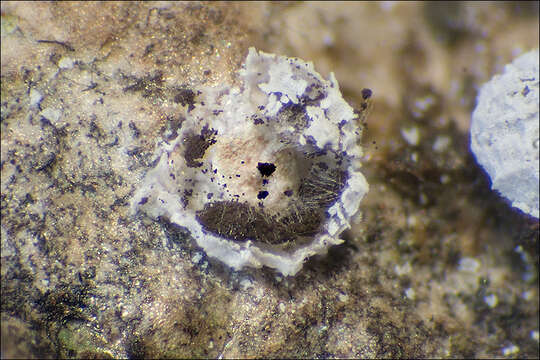Didymium-squamulosum_columella-b_8M

Description:
Didymium squamulosum (Alb. & Schwein.) Fr., Syn.: Cionium squamulosum (Alb. & Schwein.) Spreng., Diderma squamulosum Alb. & Schwein., Didymium effusum Link, Physarum effusum Link.Family: DidymiaceaeEN: no vernacular name found, DE: no vernacular name foundSlo.: no vernacular name foundDat.: Oct. 30. 2020Lat.: 46.360322 Long.: 13.702932Code: Bot_1344/2020_DSC1440Habitat: Former pasture partly overgrown with tall herb, bushes and scattered trees; slightly inclined terrain, southeast aspect; calcareous, skeletal, colluvial ground; open, sunny place; exposed to direct precipitations, average precipitation ~ 3.000 mm/year, average temperature 7-9 deg C, elevation 600 m (1.970 feet), alpine phytogeographical region. Substratum: bark of a dead trunk of Juglans regia in its initial disintegration stage laying on ground, partly sitting on Collema sp. (probably Collema crispum = Blennothallia crispa) thallus.Place: Lower Trenta valley, right bank of river Soa; between villages Soa and Trenta; near Trenta 2b cottage, East Julian Alps, Posoje, Slovenia EC.Comment: Habit and presence of lime crystals speak almost certainly in favor of the genus Didymium. Dimensions of spores inclined me toward Didymium melanospermum (Pers.) T. Macbr. at first. However, other traits, particularly furrowed stalks, whitish stalk color (should be bark to black) and presence of lime in them (it should be absent), changed my initial supposition in favor to similar Didymium squamulosum (Alb. & Schwein.) Fr. in spite of the fact that measured spore dimensions doesn't fit so nicely to the second option. Another discrepancy of the find (related to booth species) is the fact that vast majority of the sporocarps appeared sessile, while they should normally be distinctly stalked and only rarely 'sessile'. According to literature Didymium squamulosum is considered a very variable species and apparently sessile sporocarps are found occasionally too, so they may not be a severe argument against this determination.Description: Sporocarps up to 1.1 mm tall, most of them seemingly sessile having rudimentary stalks hidden in strongly umbicilate sporocysts below; only a few distinctly stalked; sporocysts sub-globose or oblate, 0.6-1 mm in diameter, when wet bluish-gray, half dry pale-gray, when dry white; with simple, membranous, colorless to light-yellowish, translucent peridium covered by a thick layer of crystalline lime; crystals usually larger than spores; (hypo)columella present, flattened, perimeter about 1/3 or slightly less of the sporocysts perimeter; white to beige, light brownish (best seen in transparent light); capillitium thin, scantily branched with rare, small nodular swellings; attached to peridium. Stalks short, mostly hidden; some distinct but not longer than 2/3 of sporocysts diameter, longitudinally striate, No confluent plasmodial form observed at the site of stalk attachment to substrate.To our knowledge, up to present three observations of this rare (or overlooked) species in Slovenia have been described up to now (Ref.:5, Ref.:6 and Ref.:7). Microscopy: Spores densely warted (< 0.5m high warts), globose to sub-globose dark brown to black on mass (dry); dimensions: (10,5)10,8 - 12(12,6) (9,9)10,4 - 11,5(11,9) m; Q = 1 - 1,1; N = 21; Me = 11,4 10,9 m; Qe = 1. Olympus CH20, NEA 100x/1.25, magnification 1.000 x, oil (spores, capillitium), NEA 40x/0.65, magnification 400x (lime crystals, stalk), NEA 10x/0.25, magnification 100x (capillitium); in water; fresh and dried material. AmScope MA500 digital camera. Columella, stalk and capillitium also: Sony ILCE6000 on trino-stereomicroscope Novex RZ, Holland.Ref.:(1) H. Neubert, W. Nowotny, K. Baumann - H. Marx, Die Myxomyceten Deutschlands und des angrenzenden Alpenraumes unter besonderen Bercksichtigung sterreichs, Vol., 2., Karlheinz Baumann Verlag, (1995), p 129 (D. melanospermum p 117).(2) M. Poulain, M. Meyer, J. Borronet, Les Myxomycetes, FMBDS (2011), Vol.1., p 463 (D. melanospermum 466).(2b) M. Poulain, M. Meyer, J. Borronet, Les Myxomycetes, FMBDS (2011), Vol.2. p 383.(3) sarahlloydmyxos.wordpress.com/identification/#jp-carousel... (accessed Dec. 01. 2020)(4) digitalcommons.mtu.edu/cgi/viewcontent.cgi?article=1218&a... , p3-2-25 (accessed Dec. 01. 2020)(5) S. Behri, Raznolikost Pravih Sluzavk v okolici Mengea, (in Slovene) (True Slime Molds (Myxomicetes) Diversity in Vicinity of Menge) (in Slovene), Graduation Thesis, University Studies, University in Ljubljana, Biotechnical Faculty, Biology department (2015).(6) N. Ogris (ed), Boletus informaticus, Slovenian Forestry Institute www.zdravgozd.si/bi_index.aspx (accessed Dec. 12. 2020)(7) Voss W. Mycologia Carniolica: ein Beitrag zur Pilzkunde des Alpenlandes (1892), Berlin, R. Friedlander & Sohn, Camera: Sony ILCE6000 on trinocular stereomicroscope Novex RZ, Holland
Included On The Following Pages:
- Life (creatures)
- Cellular (cellular organisms)
- Eukaryota (eukaryotes)
- Amoebozoa (amoeboid protists)
- Evosea
- Eumycetozoa (slime molds)
- Myxogastria (plasmodial slime molds)
- Myxogastromycetidae
- Physariida
- Didymiaceae
- Didymium
- Didymium squamulosum
This image is not featured in any collections.
Source Information
- license
- cc-by-nc-sa
- copyright
- Amadej Trnkoczy
- photographer
- Amadej Trnkoczy
- original
- original media file
- visit source
- partner site
- Flickr Group
- ID


